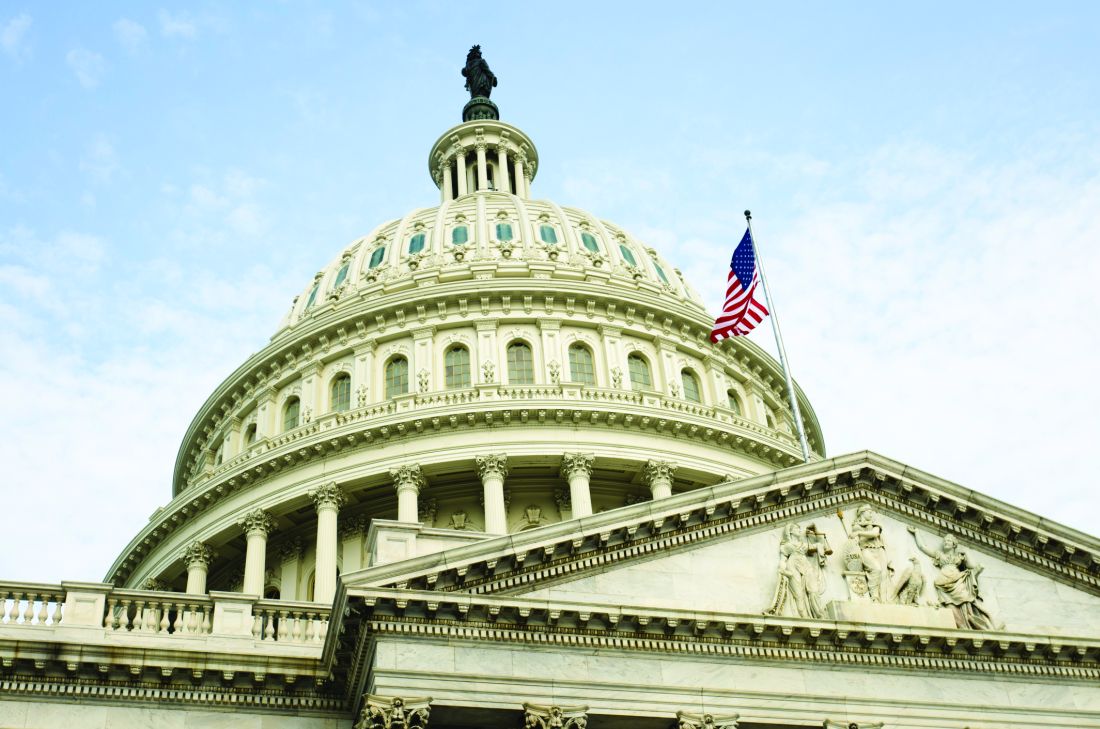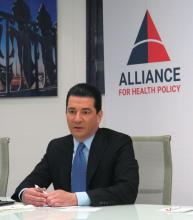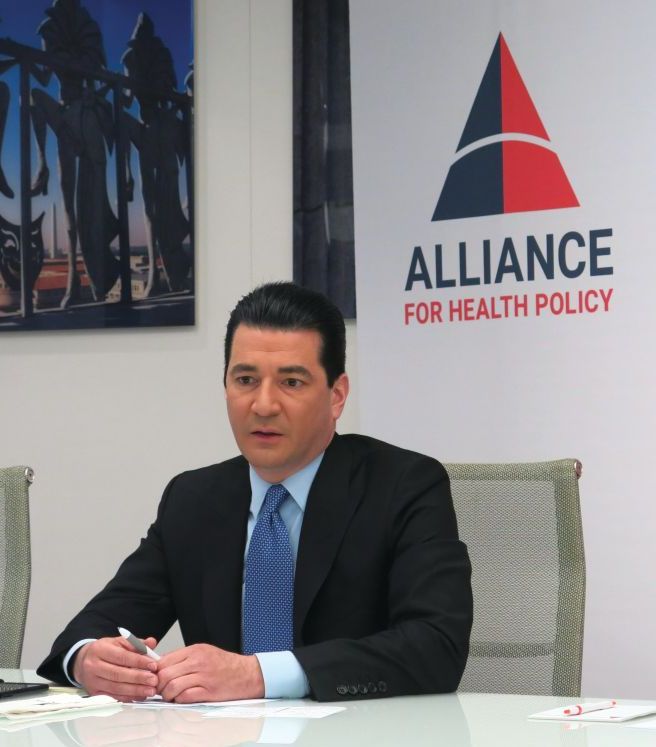User login
NIH launches HEAL Initiative to combat opioid crisis
The NIH HEAL (Helping to End Addiction Long-term) Initiative aims to bring together agencies across the federal government, as well as academic institutions, private industry, and patient advocates to find new solutions to address the current national health emergency.
“There are 15 initiatives altogether that are being put out that we think are pretty bold and should make a big difference in our understanding of what to do about this national public health crisis,” NIH Director Francis Collins, MD, said in an interview.
HEAL will investigate ways to reformulate existing treatments for opioid use disorder (OUD), to improve efficacy and extend their availability to more patients.
“Although there are effective medications for OUD (methadone, buprenorphine, and naltrexone), only a small percentage of individuals in the United States who would benefit receive these medications,” according to an editorial introducing the NIH HEAL Initiative published in JAMA (doi:10.1001/jama.2018.8826). “Even among those who have initiated these medications, about half will relapse within 6 months.”
The editorial was authored by Dr. Collins, Walter J. Koroshetz, MD, director of the National Institute of Neurological Disorders and Stroke, and Nora Volkow, MD, director of the National Institute on Drug Abuse.
For example, the current formulation of naltrexone lasts about a month within the body, Dr. Collins said in an interview. “If we had a 6-month version of that, I think it would be much more effective because oftentimes the relapses happen after a month or so, before people have fully gotten themselves on the ground.”
Better overdose antidotes are needed as well, he said, particularly for fentanyl overdose. “Narcan may not be strong enough for those long-lasting and very potent opioids like fentanyl,” he said.
HEAL also will seek a better understanding of neonatal opioid withdrawal syndrome (NOWS), also referred to as neonatal abstinence syndrome, which has become alarmingly common as more women of childbearing potential struggle with opioid addiction.
“Innovative methods to identify and treat newborns exposed to opioids, often along with other drugs, have the potential to improve both short- and long-term developmental outcomes in such children,” Dr. Collins and colleagues noted. “To determine better approaches, HEAL will expand Advancing Clinical Trials in Neonatal Opioid Withdrawal Syndrome (ACT NOW). This pilot study is designed to assess the prevalence of NOWS, understand current approaches to managing NOWS , and develop common approaches for larger-scale studies that will determine best practices for clinical care of infants with NOWS throughout the country.”
HEAL efforts also seek to find integrated approaches to OUD treatment.
“One particularly bold element is to put together a number of pilot projects that enable bringing together all of the ways in which we are trying to turn this epidemic around by making it possible to assess whether individuals who are addicted can be successfully treated and maintained in abstinence for long periods of time,” Dr. Collins said. “Right now, the success is not so great.
“Suppose we brought together all of the treatment programs – the primary care facilities, the emergency rooms, the fire departments, the social work experts, the health departments in the states, the local communities, the criminal justice system. We brought together all of those players in a research design where we can really see what was working. Could we do a lot more to turn this around than basically doing one of those at a time? There is this multisite idea of a national research effort, still somewhat in development, but to do integration of all of these efforts. I am pretty excited about that one.”
In looking for better ways to treat pain safely and effectively, “we need to understand how it is that people transition from acute pain to chronic pain … and what can we do increase the likelihood of recovery from acute pain without making that transition,” Dr. Collins said. “Then we need to identify additional novel targets for developing pain therapies, both devices and pharmaceuticals. We need better means of testing those ideas.”
In addition to gaining a better understanding of chronic pain, HEAL aims to investigate new nonaddictive pain treatments and find ways to expedite those treatments through the clinical pipeline, according to Dr. Collins and colleagues.
HEAL “lays the foundation for an innovative therapy-development pipeline through a planned new public-private partnership. In collaboration with biopharmaceutical groups, the Food and Drug Administration, and the Foundation for the NIH, the NIH will collect and evaluate treatment assets from academia and biopharmaceutical and device companies to coordinate and accelerate the development of effective treatments for pain and addiction,” they wrote.
SOURCE: Collins F et al, JAMA doi: 10.1001/jama.2018.8826.
The NIH HEAL (Helping to End Addiction Long-term) Initiative aims to bring together agencies across the federal government, as well as academic institutions, private industry, and patient advocates to find new solutions to address the current national health emergency.
“There are 15 initiatives altogether that are being put out that we think are pretty bold and should make a big difference in our understanding of what to do about this national public health crisis,” NIH Director Francis Collins, MD, said in an interview.
HEAL will investigate ways to reformulate existing treatments for opioid use disorder (OUD), to improve efficacy and extend their availability to more patients.
“Although there are effective medications for OUD (methadone, buprenorphine, and naltrexone), only a small percentage of individuals in the United States who would benefit receive these medications,” according to an editorial introducing the NIH HEAL Initiative published in JAMA (doi:10.1001/jama.2018.8826). “Even among those who have initiated these medications, about half will relapse within 6 months.”
The editorial was authored by Dr. Collins, Walter J. Koroshetz, MD, director of the National Institute of Neurological Disorders and Stroke, and Nora Volkow, MD, director of the National Institute on Drug Abuse.
For example, the current formulation of naltrexone lasts about a month within the body, Dr. Collins said in an interview. “If we had a 6-month version of that, I think it would be much more effective because oftentimes the relapses happen after a month or so, before people have fully gotten themselves on the ground.”
Better overdose antidotes are needed as well, he said, particularly for fentanyl overdose. “Narcan may not be strong enough for those long-lasting and very potent opioids like fentanyl,” he said.
HEAL also will seek a better understanding of neonatal opioid withdrawal syndrome (NOWS), also referred to as neonatal abstinence syndrome, which has become alarmingly common as more women of childbearing potential struggle with opioid addiction.
“Innovative methods to identify and treat newborns exposed to opioids, often along with other drugs, have the potential to improve both short- and long-term developmental outcomes in such children,” Dr. Collins and colleagues noted. “To determine better approaches, HEAL will expand Advancing Clinical Trials in Neonatal Opioid Withdrawal Syndrome (ACT NOW). This pilot study is designed to assess the prevalence of NOWS, understand current approaches to managing NOWS , and develop common approaches for larger-scale studies that will determine best practices for clinical care of infants with NOWS throughout the country.”
HEAL efforts also seek to find integrated approaches to OUD treatment.
“One particularly bold element is to put together a number of pilot projects that enable bringing together all of the ways in which we are trying to turn this epidemic around by making it possible to assess whether individuals who are addicted can be successfully treated and maintained in abstinence for long periods of time,” Dr. Collins said. “Right now, the success is not so great.
“Suppose we brought together all of the treatment programs – the primary care facilities, the emergency rooms, the fire departments, the social work experts, the health departments in the states, the local communities, the criminal justice system. We brought together all of those players in a research design where we can really see what was working. Could we do a lot more to turn this around than basically doing one of those at a time? There is this multisite idea of a national research effort, still somewhat in development, but to do integration of all of these efforts. I am pretty excited about that one.”
In looking for better ways to treat pain safely and effectively, “we need to understand how it is that people transition from acute pain to chronic pain … and what can we do increase the likelihood of recovery from acute pain without making that transition,” Dr. Collins said. “Then we need to identify additional novel targets for developing pain therapies, both devices and pharmaceuticals. We need better means of testing those ideas.”
In addition to gaining a better understanding of chronic pain, HEAL aims to investigate new nonaddictive pain treatments and find ways to expedite those treatments through the clinical pipeline, according to Dr. Collins and colleagues.
HEAL “lays the foundation for an innovative therapy-development pipeline through a planned new public-private partnership. In collaboration with biopharmaceutical groups, the Food and Drug Administration, and the Foundation for the NIH, the NIH will collect and evaluate treatment assets from academia and biopharmaceutical and device companies to coordinate and accelerate the development of effective treatments for pain and addiction,” they wrote.
SOURCE: Collins F et al, JAMA doi: 10.1001/jama.2018.8826.
The NIH HEAL (Helping to End Addiction Long-term) Initiative aims to bring together agencies across the federal government, as well as academic institutions, private industry, and patient advocates to find new solutions to address the current national health emergency.
“There are 15 initiatives altogether that are being put out that we think are pretty bold and should make a big difference in our understanding of what to do about this national public health crisis,” NIH Director Francis Collins, MD, said in an interview.
HEAL will investigate ways to reformulate existing treatments for opioid use disorder (OUD), to improve efficacy and extend their availability to more patients.
“Although there are effective medications for OUD (methadone, buprenorphine, and naltrexone), only a small percentage of individuals in the United States who would benefit receive these medications,” according to an editorial introducing the NIH HEAL Initiative published in JAMA (doi:10.1001/jama.2018.8826). “Even among those who have initiated these medications, about half will relapse within 6 months.”
The editorial was authored by Dr. Collins, Walter J. Koroshetz, MD, director of the National Institute of Neurological Disorders and Stroke, and Nora Volkow, MD, director of the National Institute on Drug Abuse.
For example, the current formulation of naltrexone lasts about a month within the body, Dr. Collins said in an interview. “If we had a 6-month version of that, I think it would be much more effective because oftentimes the relapses happen after a month or so, before people have fully gotten themselves on the ground.”
Better overdose antidotes are needed as well, he said, particularly for fentanyl overdose. “Narcan may not be strong enough for those long-lasting and very potent opioids like fentanyl,” he said.
HEAL also will seek a better understanding of neonatal opioid withdrawal syndrome (NOWS), also referred to as neonatal abstinence syndrome, which has become alarmingly common as more women of childbearing potential struggle with opioid addiction.
“Innovative methods to identify and treat newborns exposed to opioids, often along with other drugs, have the potential to improve both short- and long-term developmental outcomes in such children,” Dr. Collins and colleagues noted. “To determine better approaches, HEAL will expand Advancing Clinical Trials in Neonatal Opioid Withdrawal Syndrome (ACT NOW). This pilot study is designed to assess the prevalence of NOWS, understand current approaches to managing NOWS , and develop common approaches for larger-scale studies that will determine best practices for clinical care of infants with NOWS throughout the country.”
HEAL efforts also seek to find integrated approaches to OUD treatment.
“One particularly bold element is to put together a number of pilot projects that enable bringing together all of the ways in which we are trying to turn this epidemic around by making it possible to assess whether individuals who are addicted can be successfully treated and maintained in abstinence for long periods of time,” Dr. Collins said. “Right now, the success is not so great.
“Suppose we brought together all of the treatment programs – the primary care facilities, the emergency rooms, the fire departments, the social work experts, the health departments in the states, the local communities, the criminal justice system. We brought together all of those players in a research design where we can really see what was working. Could we do a lot more to turn this around than basically doing one of those at a time? There is this multisite idea of a national research effort, still somewhat in development, but to do integration of all of these efforts. I am pretty excited about that one.”
In looking for better ways to treat pain safely and effectively, “we need to understand how it is that people transition from acute pain to chronic pain … and what can we do increase the likelihood of recovery from acute pain without making that transition,” Dr. Collins said. “Then we need to identify additional novel targets for developing pain therapies, both devices and pharmaceuticals. We need better means of testing those ideas.”
In addition to gaining a better understanding of chronic pain, HEAL aims to investigate new nonaddictive pain treatments and find ways to expedite those treatments through the clinical pipeline, according to Dr. Collins and colleagues.
HEAL “lays the foundation for an innovative therapy-development pipeline through a planned new public-private partnership. In collaboration with biopharmaceutical groups, the Food and Drug Administration, and the Foundation for the NIH, the NIH will collect and evaluate treatment assets from academia and biopharmaceutical and device companies to coordinate and accelerate the development of effective treatments for pain and addiction,” they wrote.
SOURCE: Collins F et al, JAMA doi: 10.1001/jama.2018.8826.
FROM JAMA
DOJ won’t defend ACA from lawsuit challenging constitutionality
The Department of Justice is declining to interfere with a legal action that could have the significant impact on the Affordable Care Act, filing a brief stating that it will not defend the law in the case Texas v. The United States.
In February 2018, Texas and 19 other states filed a lawsuit in the U.S. District Court for the Northern District of Texas, Fort Worth Division, seeking to have the ACA’s individual mandate declared unconstitutional in light of the mandate’s penalty being reduced to zero effective Jan. 1, 2019. Congress eliminated the financial penalty for not carrying qualifying insurance coverage as part of the Tax Cuts and Jobs Act of 2017.
Taking it further, the plaintiffs argue in their court filing that if the individual mandate is found to be unconstitutional, the ACA “must be invalidated as a whole,” though they suggest that at minimum, “the guaranteed-issue and community rating provisions are non-severable from the mandate and must be invalidated along with the individual mandate.”
The Supreme Court in the 2012 case National Federation of Independent Business v. Sebelius ruled that the penalty associated with the individual mandate could be characterized as a tax and as such rejected the argument that the penalty and the individual mandate were unconstitutional. But since the repeal of the individual mandate and the government’s collection of revenue in conjunction with the mandate, the “ACA lacks a rational basis,” according to the plaintiffs.
DOJ signaled on June 7 that it is siding with the plaintiffs and will not be defending the Affordable Care Act in court.
In a letter sent the same day to House Minority Leader Nancy Pelosi, (D-Calif.), U.S. Attorney General Jeff Sessions said that after “careful consideration, and with the approval of the President of the United States, I have determined that ... the Department of Justice will not defend the constitutionality of the [individual mandate] and will argue that certain provisions of the Affordable Care Act (ACA) are inseverable from that provision.”
Mr. Sessions said in the letter that the plaintiffs “are correct” in determining that the individual mandate is unconstitutional in light of the legislative action to eliminate the penalty for not complying with the individual mandate.
However, the DOJ does not agree that the balance of the law outside of the individual mandate and the inseverable guaranteed issue and community rating provisions should remain in tact.
The court filing argues that the request for a temporary injunction to declare the individual mandate unconstitutional should not be allowed because the individual mandate’s penalty for non-coverage is in effect through 2018, therefore it remains constitutional.
“That said, because this is a pure question of law on which the Plaintiffs and Defendants do not disagree, the Court should consider construing Plaintiff’s motion as a request for summary judgment and then entering a declaratory judgment that the ACA’s provisions establishing the individual mandate as well as the guaranteed-issue and community-rating requirements will all be invalid as of January 1, 2019. That would be adequate relief against the government.”
Former CMS Administrator Andy Slavitt in a tweet called the government’s desire to push any decision until the new year, which would come after the midterm elections, an act of “savage cynicism.” He added in a later tweet that “people who care about public health don’t do this. People who care about the rule of law don’t do this.”
If the plaintiffs are successful in this lawsuit, it could have significant ramifications for Americans.
“If the judge buys the administration’s argument, and if his ruling is upheld on appeal, 52 million Americans with preexisting conditions could face denial of coverage or higher premiums,” Timothy Jost, emeritus professor, Washington and Lee University School of Law, said in a blog post published on The Commonwealth Fund website. “The administration’s argument would also allow insurers to charge women, older people, and people in certain occupations higher premiums. This policy change would jeopardize coverage not just for consumers in the individual market, but also people with preexisting conditions who have employer-sponsored coverage. If these people lost or left their jobs, they may not be able to get individual market coverage.”
The American Cancer Society Cancer Action Network, American Diabetes Association, American Heart Association, American Lung Association, and the National Multiple Sclerosis Society criticized the position taken by DOJ.
“Members of Congress on both sides of the aisle have been emphatic that critical protections should not be repealed without a replacement that would ensure patients can continue to have access to care,” the organizations said in a joint statement. “If the court strikes down these protections, that exact repeal without replace scenario will occur. Should this case be successful, people with cancer, heart disease, diabetes, and any serious or chronic condition are likely to be denied coverage due to their preexisting conditions or charged such high premiums because of their health status that they will be unable to afford any coverage that may be offered.”
The Department of Justice is declining to interfere with a legal action that could have the significant impact on the Affordable Care Act, filing a brief stating that it will not defend the law in the case Texas v. The United States.
In February 2018, Texas and 19 other states filed a lawsuit in the U.S. District Court for the Northern District of Texas, Fort Worth Division, seeking to have the ACA’s individual mandate declared unconstitutional in light of the mandate’s penalty being reduced to zero effective Jan. 1, 2019. Congress eliminated the financial penalty for not carrying qualifying insurance coverage as part of the Tax Cuts and Jobs Act of 2017.
Taking it further, the plaintiffs argue in their court filing that if the individual mandate is found to be unconstitutional, the ACA “must be invalidated as a whole,” though they suggest that at minimum, “the guaranteed-issue and community rating provisions are non-severable from the mandate and must be invalidated along with the individual mandate.”
The Supreme Court in the 2012 case National Federation of Independent Business v. Sebelius ruled that the penalty associated with the individual mandate could be characterized as a tax and as such rejected the argument that the penalty and the individual mandate were unconstitutional. But since the repeal of the individual mandate and the government’s collection of revenue in conjunction with the mandate, the “ACA lacks a rational basis,” according to the plaintiffs.
DOJ signaled on June 7 that it is siding with the plaintiffs and will not be defending the Affordable Care Act in court.
In a letter sent the same day to House Minority Leader Nancy Pelosi, (D-Calif.), U.S. Attorney General Jeff Sessions said that after “careful consideration, and with the approval of the President of the United States, I have determined that ... the Department of Justice will not defend the constitutionality of the [individual mandate] and will argue that certain provisions of the Affordable Care Act (ACA) are inseverable from that provision.”
Mr. Sessions said in the letter that the plaintiffs “are correct” in determining that the individual mandate is unconstitutional in light of the legislative action to eliminate the penalty for not complying with the individual mandate.
However, the DOJ does not agree that the balance of the law outside of the individual mandate and the inseverable guaranteed issue and community rating provisions should remain in tact.
The court filing argues that the request for a temporary injunction to declare the individual mandate unconstitutional should not be allowed because the individual mandate’s penalty for non-coverage is in effect through 2018, therefore it remains constitutional.
“That said, because this is a pure question of law on which the Plaintiffs and Defendants do not disagree, the Court should consider construing Plaintiff’s motion as a request for summary judgment and then entering a declaratory judgment that the ACA’s provisions establishing the individual mandate as well as the guaranteed-issue and community-rating requirements will all be invalid as of January 1, 2019. That would be adequate relief against the government.”
Former CMS Administrator Andy Slavitt in a tweet called the government’s desire to push any decision until the new year, which would come after the midterm elections, an act of “savage cynicism.” He added in a later tweet that “people who care about public health don’t do this. People who care about the rule of law don’t do this.”
If the plaintiffs are successful in this lawsuit, it could have significant ramifications for Americans.
“If the judge buys the administration’s argument, and if his ruling is upheld on appeal, 52 million Americans with preexisting conditions could face denial of coverage or higher premiums,” Timothy Jost, emeritus professor, Washington and Lee University School of Law, said in a blog post published on The Commonwealth Fund website. “The administration’s argument would also allow insurers to charge women, older people, and people in certain occupations higher premiums. This policy change would jeopardize coverage not just for consumers in the individual market, but also people with preexisting conditions who have employer-sponsored coverage. If these people lost or left their jobs, they may not be able to get individual market coverage.”
The American Cancer Society Cancer Action Network, American Diabetes Association, American Heart Association, American Lung Association, and the National Multiple Sclerosis Society criticized the position taken by DOJ.
“Members of Congress on both sides of the aisle have been emphatic that critical protections should not be repealed without a replacement that would ensure patients can continue to have access to care,” the organizations said in a joint statement. “If the court strikes down these protections, that exact repeal without replace scenario will occur. Should this case be successful, people with cancer, heart disease, diabetes, and any serious or chronic condition are likely to be denied coverage due to their preexisting conditions or charged such high premiums because of their health status that they will be unable to afford any coverage that may be offered.”
The Department of Justice is declining to interfere with a legal action that could have the significant impact on the Affordable Care Act, filing a brief stating that it will not defend the law in the case Texas v. The United States.
In February 2018, Texas and 19 other states filed a lawsuit in the U.S. District Court for the Northern District of Texas, Fort Worth Division, seeking to have the ACA’s individual mandate declared unconstitutional in light of the mandate’s penalty being reduced to zero effective Jan. 1, 2019. Congress eliminated the financial penalty for not carrying qualifying insurance coverage as part of the Tax Cuts and Jobs Act of 2017.
Taking it further, the plaintiffs argue in their court filing that if the individual mandate is found to be unconstitutional, the ACA “must be invalidated as a whole,” though they suggest that at minimum, “the guaranteed-issue and community rating provisions are non-severable from the mandate and must be invalidated along with the individual mandate.”
The Supreme Court in the 2012 case National Federation of Independent Business v. Sebelius ruled that the penalty associated with the individual mandate could be characterized as a tax and as such rejected the argument that the penalty and the individual mandate were unconstitutional. But since the repeal of the individual mandate and the government’s collection of revenue in conjunction with the mandate, the “ACA lacks a rational basis,” according to the plaintiffs.
DOJ signaled on June 7 that it is siding with the plaintiffs and will not be defending the Affordable Care Act in court.
In a letter sent the same day to House Minority Leader Nancy Pelosi, (D-Calif.), U.S. Attorney General Jeff Sessions said that after “careful consideration, and with the approval of the President of the United States, I have determined that ... the Department of Justice will not defend the constitutionality of the [individual mandate] and will argue that certain provisions of the Affordable Care Act (ACA) are inseverable from that provision.”
Mr. Sessions said in the letter that the plaintiffs “are correct” in determining that the individual mandate is unconstitutional in light of the legislative action to eliminate the penalty for not complying with the individual mandate.
However, the DOJ does not agree that the balance of the law outside of the individual mandate and the inseverable guaranteed issue and community rating provisions should remain in tact.
The court filing argues that the request for a temporary injunction to declare the individual mandate unconstitutional should not be allowed because the individual mandate’s penalty for non-coverage is in effect through 2018, therefore it remains constitutional.
“That said, because this is a pure question of law on which the Plaintiffs and Defendants do not disagree, the Court should consider construing Plaintiff’s motion as a request for summary judgment and then entering a declaratory judgment that the ACA’s provisions establishing the individual mandate as well as the guaranteed-issue and community-rating requirements will all be invalid as of January 1, 2019. That would be adequate relief against the government.”
Former CMS Administrator Andy Slavitt in a tweet called the government’s desire to push any decision until the new year, which would come after the midterm elections, an act of “savage cynicism.” He added in a later tweet that “people who care about public health don’t do this. People who care about the rule of law don’t do this.”
If the plaintiffs are successful in this lawsuit, it could have significant ramifications for Americans.
“If the judge buys the administration’s argument, and if his ruling is upheld on appeal, 52 million Americans with preexisting conditions could face denial of coverage or higher premiums,” Timothy Jost, emeritus professor, Washington and Lee University School of Law, said in a blog post published on The Commonwealth Fund website. “The administration’s argument would also allow insurers to charge women, older people, and people in certain occupations higher premiums. This policy change would jeopardize coverage not just for consumers in the individual market, but also people with preexisting conditions who have employer-sponsored coverage. If these people lost or left their jobs, they may not be able to get individual market coverage.”
The American Cancer Society Cancer Action Network, American Diabetes Association, American Heart Association, American Lung Association, and the National Multiple Sclerosis Society criticized the position taken by DOJ.
“Members of Congress on both sides of the aisle have been emphatic that critical protections should not be repealed without a replacement that would ensure patients can continue to have access to care,” the organizations said in a joint statement. “If the court strikes down these protections, that exact repeal without replace scenario will occur. Should this case be successful, people with cancer, heart disease, diabetes, and any serious or chronic condition are likely to be denied coverage due to their preexisting conditions or charged such high premiums because of their health status that they will be unable to afford any coverage that may be offered.”
COA files lawsuit over budget sequestration
Part B drugs administered in the physician’s office are generally reimbursed at average sales price (ASP) plus 6%, a rate set in statute by the Medicare Modernization Act of 2003 (MMA). However, the Budget Control Act of 2011 put a 2% sequestration on the federal budget, effective April 1, 2013, and extended numerous times after, most recently in the Bipartisan Budget Act of 2018. This has the effect of lowering Part B drug reimbursement to ASP + 4.3%.
“We are filing to see an injunction against the United States Department of Health and Human Services and the Office of Management and Budget [OMB] because we have exhausted all possibilities in stopping what is an unconstitutional application of the 2% sequester cut to Part B drug reimbursement,” COA President Jeff Vacirca, MD, and Executive Director Ted Okon said in a May 30 letter to HHS Secretary Alex Azar alerting him to the legal action, which was filed on May 31.
Dr. Vacirca and Mr. Okon noted that they have met with “numerous HHS and OMB officials” to explain why they believe the sequestration is unconstitutional. In the court filing, they argue that the sequestration has “invaded the legislative sphere by effectively amending the MMA” and COA argues that the executive branch “cannot alter duly enacted legislation under the guise of executing the laws.
“Putting that aside, the Balanced Budget Act provides the ability for the Executive Branch to sequester up to 2% of funds for a [Budget Control Act] sequestration for Medicare Part B ‘services’ but it does not provide the same authority for Part B drugs and does not contain any express language indicating an intent that a sequestration can be applied to alter the MMA’s statutory formula.”
Despite raising this objection, “the response we have received at HHS and OMB reflects more on the current Administration’s views on the policy of Medicare Part B drug reimbursement and not on correcting the prior Administration’s unconstitutional application of the sequester,” the letter states. “As a result, we are left with no other option but to pursue legal action, something we have clearly communicated to both HHS and OMB on several occasions, as a last resort.”
COA notes in its 2018 Community Oncology Practice Report that since the sequester went into effect in 2013, around 135 independent community cancer clinics have closed and about 190 clinics have been acquired by hospitals.
“Shifting cancer care to the outpatient hospital setting costs all taxpayers, not just Medicare beneficiaries,” the letter states. “The actuarial firm Milliman estimated the shift from 2004 to 2014 to have cost Medicare $2 billion in just one year (2014) and, as a result, an estimated $500 million in the same year to senior beneficiaries responsible for the 20% coinsurance.”
Part B drugs administered in the physician’s office are generally reimbursed at average sales price (ASP) plus 6%, a rate set in statute by the Medicare Modernization Act of 2003 (MMA). However, the Budget Control Act of 2011 put a 2% sequestration on the federal budget, effective April 1, 2013, and extended numerous times after, most recently in the Bipartisan Budget Act of 2018. This has the effect of lowering Part B drug reimbursement to ASP + 4.3%.
“We are filing to see an injunction against the United States Department of Health and Human Services and the Office of Management and Budget [OMB] because we have exhausted all possibilities in stopping what is an unconstitutional application of the 2% sequester cut to Part B drug reimbursement,” COA President Jeff Vacirca, MD, and Executive Director Ted Okon said in a May 30 letter to HHS Secretary Alex Azar alerting him to the legal action, which was filed on May 31.
Dr. Vacirca and Mr. Okon noted that they have met with “numerous HHS and OMB officials” to explain why they believe the sequestration is unconstitutional. In the court filing, they argue that the sequestration has “invaded the legislative sphere by effectively amending the MMA” and COA argues that the executive branch “cannot alter duly enacted legislation under the guise of executing the laws.
“Putting that aside, the Balanced Budget Act provides the ability for the Executive Branch to sequester up to 2% of funds for a [Budget Control Act] sequestration for Medicare Part B ‘services’ but it does not provide the same authority for Part B drugs and does not contain any express language indicating an intent that a sequestration can be applied to alter the MMA’s statutory formula.”
Despite raising this objection, “the response we have received at HHS and OMB reflects more on the current Administration’s views on the policy of Medicare Part B drug reimbursement and not on correcting the prior Administration’s unconstitutional application of the sequester,” the letter states. “As a result, we are left with no other option but to pursue legal action, something we have clearly communicated to both HHS and OMB on several occasions, as a last resort.”
COA notes in its 2018 Community Oncology Practice Report that since the sequester went into effect in 2013, around 135 independent community cancer clinics have closed and about 190 clinics have been acquired by hospitals.
“Shifting cancer care to the outpatient hospital setting costs all taxpayers, not just Medicare beneficiaries,” the letter states. “The actuarial firm Milliman estimated the shift from 2004 to 2014 to have cost Medicare $2 billion in just one year (2014) and, as a result, an estimated $500 million in the same year to senior beneficiaries responsible for the 20% coinsurance.”
Part B drugs administered in the physician’s office are generally reimbursed at average sales price (ASP) plus 6%, a rate set in statute by the Medicare Modernization Act of 2003 (MMA). However, the Budget Control Act of 2011 put a 2% sequestration on the federal budget, effective April 1, 2013, and extended numerous times after, most recently in the Bipartisan Budget Act of 2018. This has the effect of lowering Part B drug reimbursement to ASP + 4.3%.
“We are filing to see an injunction against the United States Department of Health and Human Services and the Office of Management and Budget [OMB] because we have exhausted all possibilities in stopping what is an unconstitutional application of the 2% sequester cut to Part B drug reimbursement,” COA President Jeff Vacirca, MD, and Executive Director Ted Okon said in a May 30 letter to HHS Secretary Alex Azar alerting him to the legal action, which was filed on May 31.
Dr. Vacirca and Mr. Okon noted that they have met with “numerous HHS and OMB officials” to explain why they believe the sequestration is unconstitutional. In the court filing, they argue that the sequestration has “invaded the legislative sphere by effectively amending the MMA” and COA argues that the executive branch “cannot alter duly enacted legislation under the guise of executing the laws.
“Putting that aside, the Balanced Budget Act provides the ability for the Executive Branch to sequester up to 2% of funds for a [Budget Control Act] sequestration for Medicare Part B ‘services’ but it does not provide the same authority for Part B drugs and does not contain any express language indicating an intent that a sequestration can be applied to alter the MMA’s statutory formula.”
Despite raising this objection, “the response we have received at HHS and OMB reflects more on the current Administration’s views on the policy of Medicare Part B drug reimbursement and not on correcting the prior Administration’s unconstitutional application of the sequester,” the letter states. “As a result, we are left with no other option but to pursue legal action, something we have clearly communicated to both HHS and OMB on several occasions, as a last resort.”
COA notes in its 2018 Community Oncology Practice Report that since the sequester went into effect in 2013, around 135 independent community cancer clinics have closed and about 190 clinics have been acquired by hospitals.
“Shifting cancer care to the outpatient hospital setting costs all taxpayers, not just Medicare beneficiaries,” the letter states. “The actuarial firm Milliman estimated the shift from 2004 to 2014 to have cost Medicare $2 billion in just one year (2014) and, as a result, an estimated $500 million in the same year to senior beneficiaries responsible for the 20% coinsurance.”
FDA effort focuses on approving more generic drugs
Pharmaceutical companies may be in for a more difficult time hiding behind a Risk Evaluation and Mitigation Strategy (REMS) as a way to prevent generic competition from entering the market.
The Food and Drug Administration issued two draft guidance documents on May 31 aimed at spurring on generic competition, items that are part of a broader White House strategy targeting the high price of prescription drugs.
“We have seen REMS requirements exploited in two ways,” FDA Commissioner Scott Gottlieb, MD, said in a statement. “One occurs at the front end of the drug development process, when generic drugs are being developed. The other occurs at the back end of the process, after necessary testing has been completed, when a generic drug seeks approval and market entry.”
On the front end, manufacturers use REMS to restrict the sale of drugs to keep them out of the hands of generic firms, which typically need about 5,000 doses to conduct bioequivalence and bioavailability studies, Dr. Gottlieb noted. The back-end obstacle, which happens after a generic manufacturer files application for generic approval, is what the two guidance documents address.
The first draft guidance document, “Development of a Shared System REMS,” outlines principles and recommendations for brand and generic manufacturers to develop a single REMS program that covers both products, which Dr. Gottlieb said will “enable timelier market entry for products that are part of these REMS.”
The second draft guidance document, “Waivers of the Single Shared System REMS Requirement,” describes the two circumstances under which the generic manufacturer can waive the single, shared REMS requirements:
- If the burden of forming a single, shared systems outweighs the benefits.
- If an aspect of the REMS is covered by a patent or is a trade secret and the generic company was unable to obtain a license for use.
“We believe that by making the process for developing a shared system REMS more efficient, we’ll discourage brand drug makers from using REMS as a way to block generic entry and help end some of the tactics that can delay access,” Dr. Gottlieb said. “Our safety programs shouldn’t be leveraged as a way to forestall generic entry after lawful IP has lapsed on a brand drug.”
“Today’s FDA guidance is a step in the right direction toward our common goal of lowering out-of-control drug prices,” the Campaign for Sustainable Rx Pricing said in a statement “When generic and biosimilar competition is thwarted by these abusive tactics, brand-name manufacturers, who alone control the price of their drugs, keep those prices artificially high. The problem is the price, and more competition is a proven solution.”
Comments on each of the draft guidance documents are due July 31 at www.regulations.gov.
Pharmaceutical companies may be in for a more difficult time hiding behind a Risk Evaluation and Mitigation Strategy (REMS) as a way to prevent generic competition from entering the market.
The Food and Drug Administration issued two draft guidance documents on May 31 aimed at spurring on generic competition, items that are part of a broader White House strategy targeting the high price of prescription drugs.
“We have seen REMS requirements exploited in two ways,” FDA Commissioner Scott Gottlieb, MD, said in a statement. “One occurs at the front end of the drug development process, when generic drugs are being developed. The other occurs at the back end of the process, after necessary testing has been completed, when a generic drug seeks approval and market entry.”
On the front end, manufacturers use REMS to restrict the sale of drugs to keep them out of the hands of generic firms, which typically need about 5,000 doses to conduct bioequivalence and bioavailability studies, Dr. Gottlieb noted. The back-end obstacle, which happens after a generic manufacturer files application for generic approval, is what the two guidance documents address.
The first draft guidance document, “Development of a Shared System REMS,” outlines principles and recommendations for brand and generic manufacturers to develop a single REMS program that covers both products, which Dr. Gottlieb said will “enable timelier market entry for products that are part of these REMS.”
The second draft guidance document, “Waivers of the Single Shared System REMS Requirement,” describes the two circumstances under which the generic manufacturer can waive the single, shared REMS requirements:
- If the burden of forming a single, shared systems outweighs the benefits.
- If an aspect of the REMS is covered by a patent or is a trade secret and the generic company was unable to obtain a license for use.
“We believe that by making the process for developing a shared system REMS more efficient, we’ll discourage brand drug makers from using REMS as a way to block generic entry and help end some of the tactics that can delay access,” Dr. Gottlieb said. “Our safety programs shouldn’t be leveraged as a way to forestall generic entry after lawful IP has lapsed on a brand drug.”
“Today’s FDA guidance is a step in the right direction toward our common goal of lowering out-of-control drug prices,” the Campaign for Sustainable Rx Pricing said in a statement “When generic and biosimilar competition is thwarted by these abusive tactics, brand-name manufacturers, who alone control the price of their drugs, keep those prices artificially high. The problem is the price, and more competition is a proven solution.”
Comments on each of the draft guidance documents are due July 31 at www.regulations.gov.
Pharmaceutical companies may be in for a more difficult time hiding behind a Risk Evaluation and Mitigation Strategy (REMS) as a way to prevent generic competition from entering the market.
The Food and Drug Administration issued two draft guidance documents on May 31 aimed at spurring on generic competition, items that are part of a broader White House strategy targeting the high price of prescription drugs.
“We have seen REMS requirements exploited in two ways,” FDA Commissioner Scott Gottlieb, MD, said in a statement. “One occurs at the front end of the drug development process, when generic drugs are being developed. The other occurs at the back end of the process, after necessary testing has been completed, when a generic drug seeks approval and market entry.”
On the front end, manufacturers use REMS to restrict the sale of drugs to keep them out of the hands of generic firms, which typically need about 5,000 doses to conduct bioequivalence and bioavailability studies, Dr. Gottlieb noted. The back-end obstacle, which happens after a generic manufacturer files application for generic approval, is what the two guidance documents address.
The first draft guidance document, “Development of a Shared System REMS,” outlines principles and recommendations for brand and generic manufacturers to develop a single REMS program that covers both products, which Dr. Gottlieb said will “enable timelier market entry for products that are part of these REMS.”
The second draft guidance document, “Waivers of the Single Shared System REMS Requirement,” describes the two circumstances under which the generic manufacturer can waive the single, shared REMS requirements:
- If the burden of forming a single, shared systems outweighs the benefits.
- If an aspect of the REMS is covered by a patent or is a trade secret and the generic company was unable to obtain a license for use.
“We believe that by making the process for developing a shared system REMS more efficient, we’ll discourage brand drug makers from using REMS as a way to block generic entry and help end some of the tactics that can delay access,” Dr. Gottlieb said. “Our safety programs shouldn’t be leveraged as a way to forestall generic entry after lawful IP has lapsed on a brand drug.”
“Today’s FDA guidance is a step in the right direction toward our common goal of lowering out-of-control drug prices,” the Campaign for Sustainable Rx Pricing said in a statement “When generic and biosimilar competition is thwarted by these abusive tactics, brand-name manufacturers, who alone control the price of their drugs, keep those prices artificially high. The problem is the price, and more competition is a proven solution.”
Comments on each of the draft guidance documents are due July 31 at www.regulations.gov.
Congress passes ‘right to try’ legislation
Both houses of Congress have now approved a bill to provide terminally ill patients with access to experimental treatments, despite opposition from many Democrats and more than 100 patient and physician groups. President Trump is expected to sign the legislation.
By a vote of 250-169, the House passed S. 204, the Trickett Wendler, Frank Mongiello, Jordan McLinn, and Matthew Bellina Right to Try Act of 2017 on May 22. All Republication House members voted for the bill, as did 22 Democrats. The Senate had passed the bill by unanimous consent in August 2017.
“This is dangerous legislation that threatens FDA’s [Food and Drug Administration’s] authority over insuring that medical treatments are effective,” Rep. Frank Pallone (D-N.J.), ranking member of the House Energy and Commerce Committee, said during the debate on the bill. “This bill needlessly exposes vulnerable patients to the risk of unproven medications.”
He noted the language will apply broadly to anyone who has been diagnosed with a disease but may not be terminal.
“The term ‘life-threatening disease or condition’ could include chronic and often manageable diseases, such as diabetes or chronic heart failure,” he said. “If all patients with diabetes and other chronic but manageable illnesses were eligible, you have greatly expanded the scope of the legislation well beyond the scope of most state laws and FDA’s expanded access program. This exposes an even greater number of patients to risk and undermines our clinical trial program by diverting patients from trials that could support full approval to the alternate pathway.”
The law notes that the experimental drug must have cleared phase 1 testing and experimentation, and development and testing must be ongoing. Treating physicians will not be compensated for certifying a patient as eligible to gain access to an investigational drug.
Patient and physician groups, including the American Society of Clinical Oncology, Friends of Cancer Research, American Lung Association, Cystic Fibrosis Foundation, and National Organization for Rare Disorders, voiced their opposition in a May 21 letter to House Republican and Democratic leaders.
“The Senate version of the legislation is less safe than the pathway proposed in the House version and is dangerous compared to the current [FDA] expanded access program,” according to the groups. “Both House and Senate versions would also remove FDA’s consultation on dosing, route of administration, dosing schedule, and other important safety measures available under FDA’s current expanded access program.”
The organizations noted that, while they did not support the House version, it “includes improved patient safeguards compared to the Senate version. The Senate version would negatively impact patient safety substantially, and our collective organizations are strongly opposed.”
President Trump has signaled he will sign the bill.
Both houses of Congress have now approved a bill to provide terminally ill patients with access to experimental treatments, despite opposition from many Democrats and more than 100 patient and physician groups. President Trump is expected to sign the legislation.
By a vote of 250-169, the House passed S. 204, the Trickett Wendler, Frank Mongiello, Jordan McLinn, and Matthew Bellina Right to Try Act of 2017 on May 22. All Republication House members voted for the bill, as did 22 Democrats. The Senate had passed the bill by unanimous consent in August 2017.
“This is dangerous legislation that threatens FDA’s [Food and Drug Administration’s] authority over insuring that medical treatments are effective,” Rep. Frank Pallone (D-N.J.), ranking member of the House Energy and Commerce Committee, said during the debate on the bill. “This bill needlessly exposes vulnerable patients to the risk of unproven medications.”
He noted the language will apply broadly to anyone who has been diagnosed with a disease but may not be terminal.
“The term ‘life-threatening disease or condition’ could include chronic and often manageable diseases, such as diabetes or chronic heart failure,” he said. “If all patients with diabetes and other chronic but manageable illnesses were eligible, you have greatly expanded the scope of the legislation well beyond the scope of most state laws and FDA’s expanded access program. This exposes an even greater number of patients to risk and undermines our clinical trial program by diverting patients from trials that could support full approval to the alternate pathway.”
The law notes that the experimental drug must have cleared phase 1 testing and experimentation, and development and testing must be ongoing. Treating physicians will not be compensated for certifying a patient as eligible to gain access to an investigational drug.
Patient and physician groups, including the American Society of Clinical Oncology, Friends of Cancer Research, American Lung Association, Cystic Fibrosis Foundation, and National Organization for Rare Disorders, voiced their opposition in a May 21 letter to House Republican and Democratic leaders.
“The Senate version of the legislation is less safe than the pathway proposed in the House version and is dangerous compared to the current [FDA] expanded access program,” according to the groups. “Both House and Senate versions would also remove FDA’s consultation on dosing, route of administration, dosing schedule, and other important safety measures available under FDA’s current expanded access program.”
The organizations noted that, while they did not support the House version, it “includes improved patient safeguards compared to the Senate version. The Senate version would negatively impact patient safety substantially, and our collective organizations are strongly opposed.”
President Trump has signaled he will sign the bill.
Both houses of Congress have now approved a bill to provide terminally ill patients with access to experimental treatments, despite opposition from many Democrats and more than 100 patient and physician groups. President Trump is expected to sign the legislation.
By a vote of 250-169, the House passed S. 204, the Trickett Wendler, Frank Mongiello, Jordan McLinn, and Matthew Bellina Right to Try Act of 2017 on May 22. All Republication House members voted for the bill, as did 22 Democrats. The Senate had passed the bill by unanimous consent in August 2017.
“This is dangerous legislation that threatens FDA’s [Food and Drug Administration’s] authority over insuring that medical treatments are effective,” Rep. Frank Pallone (D-N.J.), ranking member of the House Energy and Commerce Committee, said during the debate on the bill. “This bill needlessly exposes vulnerable patients to the risk of unproven medications.”
He noted the language will apply broadly to anyone who has been diagnosed with a disease but may not be terminal.
“The term ‘life-threatening disease or condition’ could include chronic and often manageable diseases, such as diabetes or chronic heart failure,” he said. “If all patients with diabetes and other chronic but manageable illnesses were eligible, you have greatly expanded the scope of the legislation well beyond the scope of most state laws and FDA’s expanded access program. This exposes an even greater number of patients to risk and undermines our clinical trial program by diverting patients from trials that could support full approval to the alternate pathway.”
The law notes that the experimental drug must have cleared phase 1 testing and experimentation, and development and testing must be ongoing. Treating physicians will not be compensated for certifying a patient as eligible to gain access to an investigational drug.
Patient and physician groups, including the American Society of Clinical Oncology, Friends of Cancer Research, American Lung Association, Cystic Fibrosis Foundation, and National Organization for Rare Disorders, voiced their opposition in a May 21 letter to House Republican and Democratic leaders.
“The Senate version of the legislation is less safe than the pathway proposed in the House version and is dangerous compared to the current [FDA] expanded access program,” according to the groups. “Both House and Senate versions would also remove FDA’s consultation on dosing, route of administration, dosing schedule, and other important safety measures available under FDA’s current expanded access program.”
The organizations noted that, while they did not support the House version, it “includes improved patient safeguards compared to the Senate version. The Senate version would negatively impact patient safety substantially, and our collective organizations are strongly opposed.”
President Trump has signaled he will sign the bill.
ABIM, ASCO to build new pathway for maintenance of board certification
in how they maintain board certification.
The new 2-year option developed by the two groups will replace ABIM’s planned 2-year Knowledge Check-In in Medical Oncology that was scheduled to begin in 2020. ASCO membership is not required to follow the 2-year assessment pathway.
“The new assessment pathway is the result of more than 2 years of input and feedback from ASCO members, as well as our desire to collaborate with ABIM because of their recognized expertise in assessments,” ASCO CEO Clifford A. Hudis, MD, said in the statement. “Our dual goals for reshaping the recertification process are to ensure that assessment better reflects the realities of cancer care and recognizes oncologists for their knowledge gained through educational and quality improvement activities.”
in how they maintain board certification.
The new 2-year option developed by the two groups will replace ABIM’s planned 2-year Knowledge Check-In in Medical Oncology that was scheduled to begin in 2020. ASCO membership is not required to follow the 2-year assessment pathway.
“The new assessment pathway is the result of more than 2 years of input and feedback from ASCO members, as well as our desire to collaborate with ABIM because of their recognized expertise in assessments,” ASCO CEO Clifford A. Hudis, MD, said in the statement. “Our dual goals for reshaping the recertification process are to ensure that assessment better reflects the realities of cancer care and recognizes oncologists for their knowledge gained through educational and quality improvement activities.”
in how they maintain board certification.
The new 2-year option developed by the two groups will replace ABIM’s planned 2-year Knowledge Check-In in Medical Oncology that was scheduled to begin in 2020. ASCO membership is not required to follow the 2-year assessment pathway.
“The new assessment pathway is the result of more than 2 years of input and feedback from ASCO members, as well as our desire to collaborate with ABIM because of their recognized expertise in assessments,” ASCO CEO Clifford A. Hudis, MD, said in the statement. “Our dual goals for reshaping the recertification process are to ensure that assessment better reflects the realities of cancer care and recognizes oncologists for their knowledge gained through educational and quality improvement activities.”
FDA queries more companies about youth e-cig use
Four more e-cigarette manufacturers are facing Food and Drug Administration scrutiny in an effort for the agency to better understand youth appeal and usage of e-cigarettes.
“These products should never be marketed to, sold to, or used by kids, and it’s critical that we take aggressive steps to address the youth use of these products.”
The agency is seeking information including, but not limited to, “documents related to product marketing, documents related to research on product design (as it may relate to the appeal or addictive potential for youth, youth-related adverse experiences), and consumer complaints associated with products,” the agency said in a statement.
The May 17 letters note that the four companies manufacture products similar to JUUL’s product offering, sharing similar characteristics, “including e-liquids that contain nicotine salts with corresponding high nicotine concentration, small size which makes them easily concealable, and product design features that are intuitive, even for novice [electronic nicotine delivery system] users. These attributes may relate to the appeal and addictiveness of the product, particularly for youth who may be experimenting with tobacco products.”
The action is the latest in the agency’s effort to combat nicotine addiction. In March, the agency issues an advanced notice of proposed rule making seeking information on the role flavoring plays in youth tobacco consumption.
Four more e-cigarette manufacturers are facing Food and Drug Administration scrutiny in an effort for the agency to better understand youth appeal and usage of e-cigarettes.
“These products should never be marketed to, sold to, or used by kids, and it’s critical that we take aggressive steps to address the youth use of these products.”
The agency is seeking information including, but not limited to, “documents related to product marketing, documents related to research on product design (as it may relate to the appeal or addictive potential for youth, youth-related adverse experiences), and consumer complaints associated with products,” the agency said in a statement.
The May 17 letters note that the four companies manufacture products similar to JUUL’s product offering, sharing similar characteristics, “including e-liquids that contain nicotine salts with corresponding high nicotine concentration, small size which makes them easily concealable, and product design features that are intuitive, even for novice [electronic nicotine delivery system] users. These attributes may relate to the appeal and addictiveness of the product, particularly for youth who may be experimenting with tobacco products.”
The action is the latest in the agency’s effort to combat nicotine addiction. In March, the agency issues an advanced notice of proposed rule making seeking information on the role flavoring plays in youth tobacco consumption.
Four more e-cigarette manufacturers are facing Food and Drug Administration scrutiny in an effort for the agency to better understand youth appeal and usage of e-cigarettes.
“These products should never be marketed to, sold to, or used by kids, and it’s critical that we take aggressive steps to address the youth use of these products.”
The agency is seeking information including, but not limited to, “documents related to product marketing, documents related to research on product design (as it may relate to the appeal or addictive potential for youth, youth-related adverse experiences), and consumer complaints associated with products,” the agency said in a statement.
The May 17 letters note that the four companies manufacture products similar to JUUL’s product offering, sharing similar characteristics, “including e-liquids that contain nicotine salts with corresponding high nicotine concentration, small size which makes them easily concealable, and product design features that are intuitive, even for novice [electronic nicotine delivery system] users. These attributes may relate to the appeal and addictiveness of the product, particularly for youth who may be experimenting with tobacco products.”
The action is the latest in the agency’s effort to combat nicotine addiction. In March, the agency issues an advanced notice of proposed rule making seeking information on the role flavoring plays in youth tobacco consumption.
FDA’s Gottlieb floats ideas on Medicare drug coverage
When the current Part B drug reimbursement scheme – average sales price plus an additional 6% to cover administration and storage – was developed, there was little competition in most of the covered therapeutic categories, Scott Gottlieb, MD, Food and Drug Administration commissioner, said May 15 at an event hosted by the Alliance for Health Policy.
The situation is different now. “Not only are these product categories multisource and in some cases quite crowded, but there is also a lot of therapeutic equivalence,” Dr. Gottlieb said. “There are a lot of other types of drugs [physicians] might use to try to address the same clinical condition.”
He specifically noted that autoimmune and inflammatory conditions have a wealth of products that address them in different ways, with the opportunity for therapeutic substitutions. He also mentioned drugs that are delivered through durable medical equipment as another area open to being moved into a more price-competitive space.
“I don’t think anyone envisioned how competitive these categories would become,” he said.
Switching drug coverage from Medicare Part B to Part D is just one of more than 50 proposals contained in a broad package introduced by the White House on May 11 to address the rising prices of prescription drugs.
“In situations where you have a lot of therapeutic variety ... you have [insurance] plans negotiating pricing using formularies and using things like step therapy, putting drugs on preferred tiers relative to the price concessions they are able to extract,” Dr. Gottlieb said.
In contrast, the current Part B [program], “looks like the small molecule world with respect to how much competition we see within some of these categories, but you don’t have the same structure. Times have changed, and I think that is why you see Secretary [Alex Azar of the Health & Human Services department] rethinking how we bid out those Part B drugs into a competitive scheme.”
Dr. Gottlieb suggested that more competition could come from the moving coverage to Medicare Part D or possibly through a reinvigorated competitive acquisition program for Part B.
When the current Part B drug reimbursement scheme – average sales price plus an additional 6% to cover administration and storage – was developed, there was little competition in most of the covered therapeutic categories, Scott Gottlieb, MD, Food and Drug Administration commissioner, said May 15 at an event hosted by the Alliance for Health Policy.
The situation is different now. “Not only are these product categories multisource and in some cases quite crowded, but there is also a lot of therapeutic equivalence,” Dr. Gottlieb said. “There are a lot of other types of drugs [physicians] might use to try to address the same clinical condition.”
He specifically noted that autoimmune and inflammatory conditions have a wealth of products that address them in different ways, with the opportunity for therapeutic substitutions. He also mentioned drugs that are delivered through durable medical equipment as another area open to being moved into a more price-competitive space.
“I don’t think anyone envisioned how competitive these categories would become,” he said.
Switching drug coverage from Medicare Part B to Part D is just one of more than 50 proposals contained in a broad package introduced by the White House on May 11 to address the rising prices of prescription drugs.
“In situations where you have a lot of therapeutic variety ... you have [insurance] plans negotiating pricing using formularies and using things like step therapy, putting drugs on preferred tiers relative to the price concessions they are able to extract,” Dr. Gottlieb said.
In contrast, the current Part B [program], “looks like the small molecule world with respect to how much competition we see within some of these categories, but you don’t have the same structure. Times have changed, and I think that is why you see Secretary [Alex Azar of the Health & Human Services department] rethinking how we bid out those Part B drugs into a competitive scheme.”
Dr. Gottlieb suggested that more competition could come from the moving coverage to Medicare Part D or possibly through a reinvigorated competitive acquisition program for Part B.
When the current Part B drug reimbursement scheme – average sales price plus an additional 6% to cover administration and storage – was developed, there was little competition in most of the covered therapeutic categories, Scott Gottlieb, MD, Food and Drug Administration commissioner, said May 15 at an event hosted by the Alliance for Health Policy.
The situation is different now. “Not only are these product categories multisource and in some cases quite crowded, but there is also a lot of therapeutic equivalence,” Dr. Gottlieb said. “There are a lot of other types of drugs [physicians] might use to try to address the same clinical condition.”
He specifically noted that autoimmune and inflammatory conditions have a wealth of products that address them in different ways, with the opportunity for therapeutic substitutions. He also mentioned drugs that are delivered through durable medical equipment as another area open to being moved into a more price-competitive space.
“I don’t think anyone envisioned how competitive these categories would become,” he said.
Switching drug coverage from Medicare Part B to Part D is just one of more than 50 proposals contained in a broad package introduced by the White House on May 11 to address the rising prices of prescription drugs.
“In situations where you have a lot of therapeutic variety ... you have [insurance] plans negotiating pricing using formularies and using things like step therapy, putting drugs on preferred tiers relative to the price concessions they are able to extract,” Dr. Gottlieb said.
In contrast, the current Part B [program], “looks like the small molecule world with respect to how much competition we see within some of these categories, but you don’t have the same structure. Times have changed, and I think that is why you see Secretary [Alex Azar of the Health & Human Services department] rethinking how we bid out those Part B drugs into a competitive scheme.”
Dr. Gottlieb suggested that more competition could come from the moving coverage to Medicare Part D or possibly through a reinvigorated competitive acquisition program for Part B.
Doctor groups float APM for treating opioid addiction
The American Society of Addiction Medicine and the American Medical Association jointly released a framework for the Patient-Centered Opioid Addiction Treatment (P-COAT) alternative payment model (APM) and are seeking comments to refine the system.
“There are many barriers to this and many reasons why ... medication-assisted treatment, is underutilized,” Patrice Harris, MD, immediate past chair of the AMA board of trustees, said in an interview. “Certainly, one of the key barriers is the current payment system. The current payment system for physicians and clinicians is generally insufficient to identify, diagnose, and treat opioid use disorder. Prior authorization also is a barrier for physicians and patients getting timely, effective treatment. Telemedicine is a critical piece of treatment because we know that in certain areas, there are not addiction specialists and there really also are not physicians qualified to prescribe medication-assisted treatment.”
Physicians participating in P-COAT would be eligible for two types of payments. The first is a one-time payment “where a physician would get paid for doing the diagnosis and the treatment planning in the beginning,” said Dr. Harris, who practices psychiatry in Atlanta. “We call that treatment induction. That might be a one-time payment for all of those services. That is the initiation of the treatment.”
The second payment is a “monthly payment for maintenance of the medical, the psychological, and the social treatments,” she said.
The payment could work in both an integrated system where all the treatment services are offered in a single setting, or via a care coordination setting where doctors may not be part of the same integrated system, she added.
“We wanted to drive coordinated care to bio-psychosocial treatment,” ASAM President Shawn Ryan, MD, said in an interview. “We want to make sure that the patient is getting medication-assisted treatment, which is standard of care for opioid use disorder. We also want to support appropriate psychosocial interventions, whether they be integrated in one site [or] if it’s a coordinated effort between a medical provider and a psychosocial intervention provider.”
As with all APMs, P-COAT would be what is called a “ two-sided risk model” where physicians would have to meet certain quality measures to qualify for bonus payments and would be penalized if they did not. Selection of appropriate measures still is being worked out and is something on which the organizations are seeking comment.
“Unfortunately, we do not have a strong set of known quality outcomes that have been appropriately vetted across the past 10 years,” said Dr. Ryan, president and chief medical officer of BrightView, an outpatient addiction medicine practice in Cincinnati. “ASAM is working on those quality outcomes parameters. As those become more codified, we put them into the model.”
At press time, there was no timeline for when P-COAT might be implemented, but ASAM is pushing to move this into practice sooner rather than later.
“I will be disappointed if we wrote a philosophy paper,” Dr. Ryan said. “That was not my goal. It is my hope that this will result in an increase of quality and quantity of delivery for opioid use disorder and providers better reimbursement to providers and more access for the payers and the members and the patients.”
AMA and ASAM are working with private payers to find an organization to pilot the alternative payment model. ASAM also said that it was in talks with the Centers for Medicare & Medicaid Services to see how to include it in federal health care programs.
The American Society of Addiction Medicine and the American Medical Association jointly released a framework for the Patient-Centered Opioid Addiction Treatment (P-COAT) alternative payment model (APM) and are seeking comments to refine the system.
“There are many barriers to this and many reasons why ... medication-assisted treatment, is underutilized,” Patrice Harris, MD, immediate past chair of the AMA board of trustees, said in an interview. “Certainly, one of the key barriers is the current payment system. The current payment system for physicians and clinicians is generally insufficient to identify, diagnose, and treat opioid use disorder. Prior authorization also is a barrier for physicians and patients getting timely, effective treatment. Telemedicine is a critical piece of treatment because we know that in certain areas, there are not addiction specialists and there really also are not physicians qualified to prescribe medication-assisted treatment.”
Physicians participating in P-COAT would be eligible for two types of payments. The first is a one-time payment “where a physician would get paid for doing the diagnosis and the treatment planning in the beginning,” said Dr. Harris, who practices psychiatry in Atlanta. “We call that treatment induction. That might be a one-time payment for all of those services. That is the initiation of the treatment.”
The second payment is a “monthly payment for maintenance of the medical, the psychological, and the social treatments,” she said.
The payment could work in both an integrated system where all the treatment services are offered in a single setting, or via a care coordination setting where doctors may not be part of the same integrated system, she added.
“We wanted to drive coordinated care to bio-psychosocial treatment,” ASAM President Shawn Ryan, MD, said in an interview. “We want to make sure that the patient is getting medication-assisted treatment, which is standard of care for opioid use disorder. We also want to support appropriate psychosocial interventions, whether they be integrated in one site [or] if it’s a coordinated effort between a medical provider and a psychosocial intervention provider.”
As with all APMs, P-COAT would be what is called a “ two-sided risk model” where physicians would have to meet certain quality measures to qualify for bonus payments and would be penalized if they did not. Selection of appropriate measures still is being worked out and is something on which the organizations are seeking comment.
“Unfortunately, we do not have a strong set of known quality outcomes that have been appropriately vetted across the past 10 years,” said Dr. Ryan, president and chief medical officer of BrightView, an outpatient addiction medicine practice in Cincinnati. “ASAM is working on those quality outcomes parameters. As those become more codified, we put them into the model.”
At press time, there was no timeline for when P-COAT might be implemented, but ASAM is pushing to move this into practice sooner rather than later.
“I will be disappointed if we wrote a philosophy paper,” Dr. Ryan said. “That was not my goal. It is my hope that this will result in an increase of quality and quantity of delivery for opioid use disorder and providers better reimbursement to providers and more access for the payers and the members and the patients.”
AMA and ASAM are working with private payers to find an organization to pilot the alternative payment model. ASAM also said that it was in talks with the Centers for Medicare & Medicaid Services to see how to include it in federal health care programs.
The American Society of Addiction Medicine and the American Medical Association jointly released a framework for the Patient-Centered Opioid Addiction Treatment (P-COAT) alternative payment model (APM) and are seeking comments to refine the system.
“There are many barriers to this and many reasons why ... medication-assisted treatment, is underutilized,” Patrice Harris, MD, immediate past chair of the AMA board of trustees, said in an interview. “Certainly, one of the key barriers is the current payment system. The current payment system for physicians and clinicians is generally insufficient to identify, diagnose, and treat opioid use disorder. Prior authorization also is a barrier for physicians and patients getting timely, effective treatment. Telemedicine is a critical piece of treatment because we know that in certain areas, there are not addiction specialists and there really also are not physicians qualified to prescribe medication-assisted treatment.”
Physicians participating in P-COAT would be eligible for two types of payments. The first is a one-time payment “where a physician would get paid for doing the diagnosis and the treatment planning in the beginning,” said Dr. Harris, who practices psychiatry in Atlanta. “We call that treatment induction. That might be a one-time payment for all of those services. That is the initiation of the treatment.”
The second payment is a “monthly payment for maintenance of the medical, the psychological, and the social treatments,” she said.
The payment could work in both an integrated system where all the treatment services are offered in a single setting, or via a care coordination setting where doctors may not be part of the same integrated system, she added.
“We wanted to drive coordinated care to bio-psychosocial treatment,” ASAM President Shawn Ryan, MD, said in an interview. “We want to make sure that the patient is getting medication-assisted treatment, which is standard of care for opioid use disorder. We also want to support appropriate psychosocial interventions, whether they be integrated in one site [or] if it’s a coordinated effort between a medical provider and a psychosocial intervention provider.”
As with all APMs, P-COAT would be what is called a “ two-sided risk model” where physicians would have to meet certain quality measures to qualify for bonus payments and would be penalized if they did not. Selection of appropriate measures still is being worked out and is something on which the organizations are seeking comment.
“Unfortunately, we do not have a strong set of known quality outcomes that have been appropriately vetted across the past 10 years,” said Dr. Ryan, president and chief medical officer of BrightView, an outpatient addiction medicine practice in Cincinnati. “ASAM is working on those quality outcomes parameters. As those become more codified, we put them into the model.”
At press time, there was no timeline for when P-COAT might be implemented, but ASAM is pushing to move this into practice sooner rather than later.
“I will be disappointed if we wrote a philosophy paper,” Dr. Ryan said. “That was not my goal. It is my hope that this will result in an increase of quality and quantity of delivery for opioid use disorder and providers better reimbursement to providers and more access for the payers and the members and the patients.”
AMA and ASAM are working with private payers to find an organization to pilot the alternative payment model. ASAM also said that it was in talks with the Centers for Medicare & Medicaid Services to see how to include it in federal health care programs.
White House pushes transparency in drug price plan
The Trump administration believes it is a “right that, when you are sitting there with your doctor, you ought to be able to know what your out-of-pocket [cost] is for drug you are going to be prescribed under your precise drug plan. And you ought to have information on what competing drugs are that your doctor is not prescribing and what you would pay out of pocket for that.”
Price transparency is a key theme to the broad package of proposals called American Patients First that the White House released May 11. The plan includes changes that can be made immediately as well as some upon which the administration will seek public comment, according to the plan.
Another tactic the administration is considering for quick action is requiring a drug’s list prices to be included in all direct-to-consumer advertising.
The plan also calls for the banning of gag rules that prevent pharmacists from alerting patients when it would be cheaper to buy a prescribed drug without going through their insurance coverage, as well as moving certain drugs from Medicare Part B to Medicare Part D to improve the government’s ability to negotiations for lower prices.
The overall strategy is laid out across four areas:
- Increasing competition though policy measures that prevent manufacturers from gaming the patent system and promoting innovation and competition among biologics.
- Improving negotiation abilities, including doing more with value-based purchasing; allowing for more substitution, especially in the case of single-source generics; and further examination of the competitive acquisition program for Part B.
- Providing incentives to manufacturers to lower their list prices.
- Lowering out-of-pocket costs.
Currently, there is no incentive to lower drug prices, Mr. Azar noted. He called out pharmacy benefit managers (PBMs) for financially benefiting from both manufacturers and the insurers they represent and said HHS is looking into banning financial compensation to PBMs from the manufacturers. He also said the agency will be releasing a request for information on the feasibility of doing away with rebates as a means of driving manufacturers to lower their prices.
PhRMA, the lobbying group representing pharmaceutical manufacturers, said in a statement that some of the changes related to Part D “could undermine the existing structure of the program that has successfully held down costs and provided seniors with access to comprehensive prescription drug coverage. We also must avoid changes to Medicare Part B that could raise costs for seniors and limit their access to lifesaving treatments.”
The Pharmaceutical Care Management Association, the lobbying group for pharmacy benefit managers, also spoke out against the idea of eliminating rebates, noting in a statement that getting rid of them “and other price concessions would leave patients and payers, including Medicaid and Medicare, at the mercy of drug manufacturer pricing strategies. PBMs have long encouraged manufacturers to offer payers alternative ways to reduce net costs. Simply put, the easiest way to lower costs would be for drug companies to lower their prices.”
The American Medical Association voiced support for the plan.
“The AMA is pleased the Trump administration is moving forward with its effort to address seemingly arbitrary pricing for prescription drugs,” President David Barbe, MD, said in a statement “Physicians see the impact of skyrocketing prices every day as patients are often unable to afford the most medically appropriate medications – even those that have effectively controlled their medical condition for years. No one can understand the logic behind the high and fluctuating prices. We hope the administration can bring some transparency – and relief – to patients.”
During a Rose Garden ceremony to introduce the initiative, President Trump said he is targeting foreign countries that require manufacturers to sell their products well below list prices as a condition of selling in their country, forcing Americans to absorb the research and development costs via higher prices for drugs.
“It’s time to end the global freeloading once and for all,” President Trump said. “I have directed U.S. Trade Representative Bob Lighthizer to make fixing this injustice a top priority with every trading partner.”
One proposal President Trump campaigned on – giving the federal government the power to directly negotiate for drug prices – was not included in the plan.
“I am very disappointed that he has apparently dropped his support for allowing Medicare to negotiate the price of prescription drugs,” Sen. Maggie Hassan (D-N.H.) said in a statement.
Also absent from the plan: a direct negotiation tactic for Part B drugs supported by Mr. Azar during his confirmation hearings.
The Trump administration believes it is a “right that, when you are sitting there with your doctor, you ought to be able to know what your out-of-pocket [cost] is for drug you are going to be prescribed under your precise drug plan. And you ought to have information on what competing drugs are that your doctor is not prescribing and what you would pay out of pocket for that.”
Price transparency is a key theme to the broad package of proposals called American Patients First that the White House released May 11. The plan includes changes that can be made immediately as well as some upon which the administration will seek public comment, according to the plan.
Another tactic the administration is considering for quick action is requiring a drug’s list prices to be included in all direct-to-consumer advertising.
The plan also calls for the banning of gag rules that prevent pharmacists from alerting patients when it would be cheaper to buy a prescribed drug without going through their insurance coverage, as well as moving certain drugs from Medicare Part B to Medicare Part D to improve the government’s ability to negotiations for lower prices.
The overall strategy is laid out across four areas:
- Increasing competition though policy measures that prevent manufacturers from gaming the patent system and promoting innovation and competition among biologics.
- Improving negotiation abilities, including doing more with value-based purchasing; allowing for more substitution, especially in the case of single-source generics; and further examination of the competitive acquisition program for Part B.
- Providing incentives to manufacturers to lower their list prices.
- Lowering out-of-pocket costs.
Currently, there is no incentive to lower drug prices, Mr. Azar noted. He called out pharmacy benefit managers (PBMs) for financially benefiting from both manufacturers and the insurers they represent and said HHS is looking into banning financial compensation to PBMs from the manufacturers. He also said the agency will be releasing a request for information on the feasibility of doing away with rebates as a means of driving manufacturers to lower their prices.
PhRMA, the lobbying group representing pharmaceutical manufacturers, said in a statement that some of the changes related to Part D “could undermine the existing structure of the program that has successfully held down costs and provided seniors with access to comprehensive prescription drug coverage. We also must avoid changes to Medicare Part B that could raise costs for seniors and limit their access to lifesaving treatments.”
The Pharmaceutical Care Management Association, the lobbying group for pharmacy benefit managers, also spoke out against the idea of eliminating rebates, noting in a statement that getting rid of them “and other price concessions would leave patients and payers, including Medicaid and Medicare, at the mercy of drug manufacturer pricing strategies. PBMs have long encouraged manufacturers to offer payers alternative ways to reduce net costs. Simply put, the easiest way to lower costs would be for drug companies to lower their prices.”
The American Medical Association voiced support for the plan.
“The AMA is pleased the Trump administration is moving forward with its effort to address seemingly arbitrary pricing for prescription drugs,” President David Barbe, MD, said in a statement “Physicians see the impact of skyrocketing prices every day as patients are often unable to afford the most medically appropriate medications – even those that have effectively controlled their medical condition for years. No one can understand the logic behind the high and fluctuating prices. We hope the administration can bring some transparency – and relief – to patients.”
During a Rose Garden ceremony to introduce the initiative, President Trump said he is targeting foreign countries that require manufacturers to sell their products well below list prices as a condition of selling in their country, forcing Americans to absorb the research and development costs via higher prices for drugs.
“It’s time to end the global freeloading once and for all,” President Trump said. “I have directed U.S. Trade Representative Bob Lighthizer to make fixing this injustice a top priority with every trading partner.”
One proposal President Trump campaigned on – giving the federal government the power to directly negotiate for drug prices – was not included in the plan.
“I am very disappointed that he has apparently dropped his support for allowing Medicare to negotiate the price of prescription drugs,” Sen. Maggie Hassan (D-N.H.) said in a statement.
Also absent from the plan: a direct negotiation tactic for Part B drugs supported by Mr. Azar during his confirmation hearings.
The Trump administration believes it is a “right that, when you are sitting there with your doctor, you ought to be able to know what your out-of-pocket [cost] is for drug you are going to be prescribed under your precise drug plan. And you ought to have information on what competing drugs are that your doctor is not prescribing and what you would pay out of pocket for that.”
Price transparency is a key theme to the broad package of proposals called American Patients First that the White House released May 11. The plan includes changes that can be made immediately as well as some upon which the administration will seek public comment, according to the plan.
Another tactic the administration is considering for quick action is requiring a drug’s list prices to be included in all direct-to-consumer advertising.
The plan also calls for the banning of gag rules that prevent pharmacists from alerting patients when it would be cheaper to buy a prescribed drug without going through their insurance coverage, as well as moving certain drugs from Medicare Part B to Medicare Part D to improve the government’s ability to negotiations for lower prices.
The overall strategy is laid out across four areas:
- Increasing competition though policy measures that prevent manufacturers from gaming the patent system and promoting innovation and competition among biologics.
- Improving negotiation abilities, including doing more with value-based purchasing; allowing for more substitution, especially in the case of single-source generics; and further examination of the competitive acquisition program for Part B.
- Providing incentives to manufacturers to lower their list prices.
- Lowering out-of-pocket costs.
Currently, there is no incentive to lower drug prices, Mr. Azar noted. He called out pharmacy benefit managers (PBMs) for financially benefiting from both manufacturers and the insurers they represent and said HHS is looking into banning financial compensation to PBMs from the manufacturers. He also said the agency will be releasing a request for information on the feasibility of doing away with rebates as a means of driving manufacturers to lower their prices.
PhRMA, the lobbying group representing pharmaceutical manufacturers, said in a statement that some of the changes related to Part D “could undermine the existing structure of the program that has successfully held down costs and provided seniors with access to comprehensive prescription drug coverage. We also must avoid changes to Medicare Part B that could raise costs for seniors and limit their access to lifesaving treatments.”
The Pharmaceutical Care Management Association, the lobbying group for pharmacy benefit managers, also spoke out against the idea of eliminating rebates, noting in a statement that getting rid of them “and other price concessions would leave patients and payers, including Medicaid and Medicare, at the mercy of drug manufacturer pricing strategies. PBMs have long encouraged manufacturers to offer payers alternative ways to reduce net costs. Simply put, the easiest way to lower costs would be for drug companies to lower their prices.”
The American Medical Association voiced support for the plan.
“The AMA is pleased the Trump administration is moving forward with its effort to address seemingly arbitrary pricing for prescription drugs,” President David Barbe, MD, said in a statement “Physicians see the impact of skyrocketing prices every day as patients are often unable to afford the most medically appropriate medications – even those that have effectively controlled their medical condition for years. No one can understand the logic behind the high and fluctuating prices. We hope the administration can bring some transparency – and relief – to patients.”
During a Rose Garden ceremony to introduce the initiative, President Trump said he is targeting foreign countries that require manufacturers to sell their products well below list prices as a condition of selling in their country, forcing Americans to absorb the research and development costs via higher prices for drugs.
“It’s time to end the global freeloading once and for all,” President Trump said. “I have directed U.S. Trade Representative Bob Lighthizer to make fixing this injustice a top priority with every trading partner.”
One proposal President Trump campaigned on – giving the federal government the power to directly negotiate for drug prices – was not included in the plan.
“I am very disappointed that he has apparently dropped his support for allowing Medicare to negotiate the price of prescription drugs,” Sen. Maggie Hassan (D-N.H.) said in a statement.
Also absent from the plan: a direct negotiation tactic for Part B drugs supported by Mr. Azar during his confirmation hearings.




















